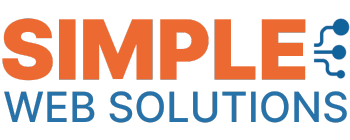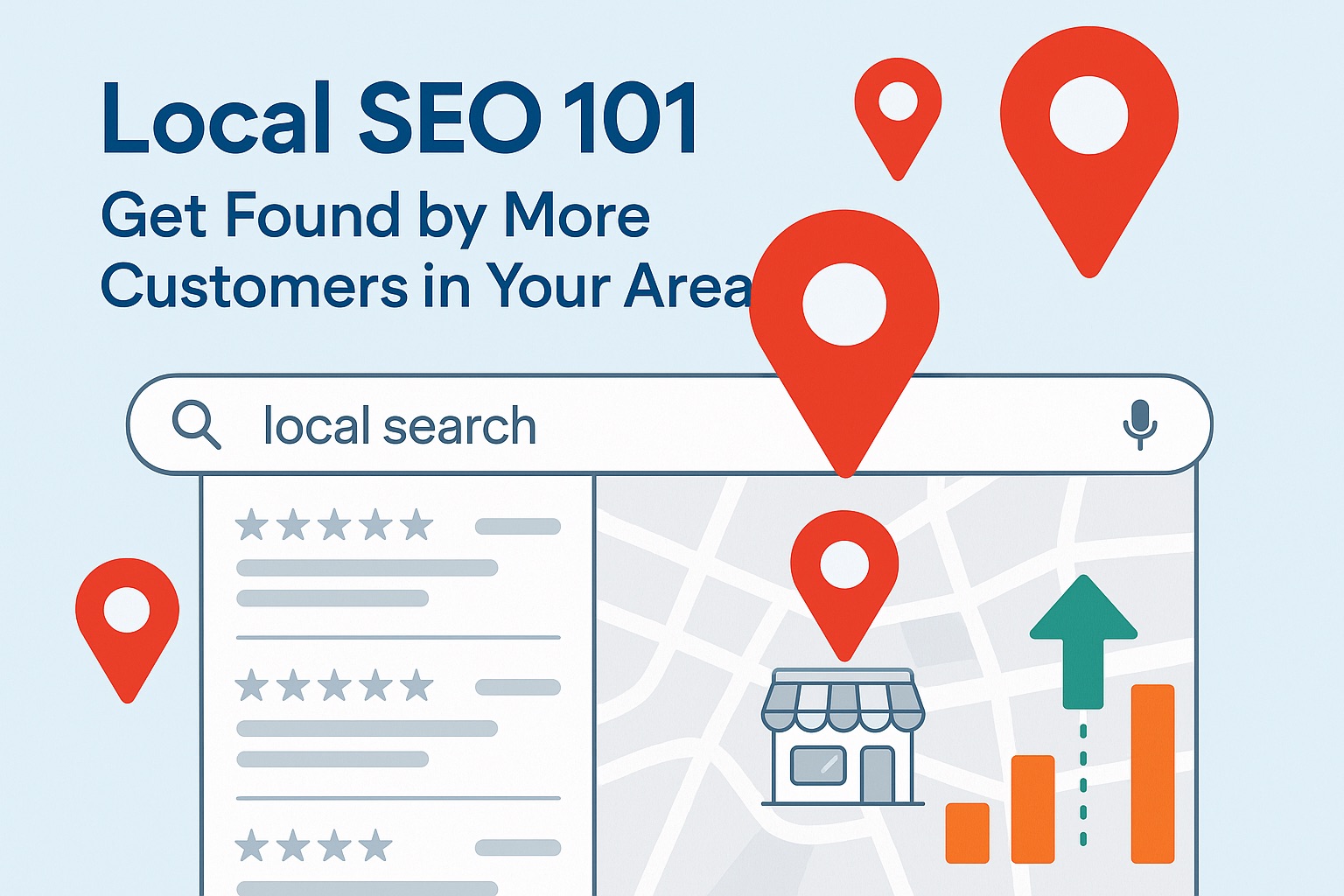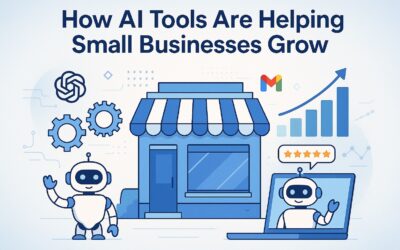What if your best potential clients can’t find you—even when they’re actively searching right where you operate? With 92% of searchers choosing companies listed on the first page of results, invisibility online could mean missing out on thousands in revenue monthly.
Modern search behavior has shifted dramatically. Phrases like “open now near me” surged 400% last year, while 72% of consumers visit stores within five miles of their location after a quick search. This isn’t about luck—it’s about strategic visibility where it matters most.
Traditional marketing methods can’t compete with algorithms prioritizing proximity and relevance. Imagine your company appearing exactly when someone needs your expertise nearby. That’s the power of tailored optimization strategies designed for geographic targeting.
Simple Web Solutions specializes in helping professionals dominate their neighborhoods digitally. We focus on clear, measurable results—no outsourcing or confusing jargon. Our approach turns complex data into actionable steps, ensuring you connect with ready-to-buy clients.
Key Takeaways
- 92% of searchers pick businesses from the first page of local results
- “Near me” searches drive 800 million monthly queries nationwide
- 72% of consumers visit stores within five miles after local searches
- Location-based optimization requires unique strategies beyond basic SEO
- First-page visibility directly impacts customer acquisition rates
Table of Contents
Understanding Local SEO Essentials
When someone nearby needs your expertise, does your digital presence answer their call? Geographic optimization bridges this gap by aligning your visibility with community demand. Unlike broader strategies, this approach prioritizes immediate relevance for those ready to act.
Defining Modern Search Dynamics
Voice-activated queries now dominate discovery patterns. Over 71% of users ask devices like Alexa for recommendations instead of typing. Mobile searches add urgency—80% of “urgent need” inquiries convert within 24 hours.
“Proximity, relevance, and prominence form the triad that determines who appears when someone needs help nearby.”
This shift demands tailored tactics. For example, “same-day repair near [city]” queries grew 240% last year. Algorithms prioritize businesses demonstrating:
| Traditional SEO Focus | Localized Strategy | Impact |
|---|---|---|
| Global keywords | Neighborhood phrases | 3x higher conversion |
| Backlink quantity | Accurate directory listings | 42% trust boost |
| Generic content | Service-area pages | 67% longer engagement |
Behavior Patterns Driving Decisions
Mobile-first users expect instant answers. Over half abandon sites taking over 3 seconds to load. They cross-reference reviews and proximity—89% choose companies within a 15-minute drive.
Simple Web Solutions transforms these insights into action. By mapping search intent to operational strengths, we help professionals dominate hyper-competitive markets. The result? Consistent visibility where it converts best.
Local SEO for Service Business: Key Strategies to Grow Your Reach
When your team operates across multiple zip codes, visibility becomes a game of precision. Companies like HVAC specialists or garage door repair crews can’t rely on foot traffic—they need digital strategies that match their operational range. This demands tailored approaches to outrank competitors in specific neighborhoods.
Optimizing Your Google Business Profile
A complete Google Business Profile acts as your 24/7 storefront. List accurate contact details, select precise categories like “emergency locksmith,” and add photos of completed projects. Profiles with regular updates receive 35% more clicks than inactive ones.
Reviews shape credibility. Encourage satisfied clients to share experiences—88% of consumers trust online reviews as much as personal recommendations. Respond promptly to feedback, addressing concerns while highlighting your responsiveness.
“Service-area providers must balance geographic reach with hyper-local relevance. Pinpoint accuracy in profiles builds trust with both algorithms and customers.”
Defining Your Service Areas Effectively
Map coverage zones using cities or ZIP codes rather than vague regions. A window cleaning company might specify “Downtown Chicago + 10-mile radius” instead of “Greater Chicago Area.” This clarity helps search engines match queries with your capabilities.
Hide physical addresses if clients don’t visit your location. Instead, emphasize operating hours and response times. Consistent citations on directories like Yelp reinforce your authority across mapped territories.
Simple Web Solutions helps contractors refine these elements systematically. By aligning digital footprints with actual service routes, professionals gain targeted exposure—exactly where demand exists.
Optimizing Your Website for Local Search Success
Imagine a customer searching for your expertise—how quickly does your site answer their needs? Your digital storefront must work harder than ever. Mobile users abandon slow-loading pages in seconds, while search algorithms prioritize sites offering seamless experiences.
Mobile-First Design and Fast-Loading Pages
Responsive design isn’t optional. Over 68% of searches start on handheld devices. Sites loading under two seconds retain 90% more visitors. Optimize images, leverage browser caching, and compress code to meet speed benchmarks.
| Traditional Approach | Modern Tactics | Result |
|---|---|---|
| Desktop-focused layouts | Dynamic mobile templates | 40% lower bounce rates |
| Heavy media files | Compressed WebP images | 2.3x faster load times |
| Generic user paths | Thumb-friendly navigation | 55% higher engagement |
Implementing Schema Markup and On-Page SEO Techniques
Structured data tells search engines exactly what you offer. Service area markup clarifies your coverage, while review schema showcases ratings directly in results. Title tags with neighborhood names boost relevance without keyword stuffing.
Simple Web Solutions crafts location-aware content that aligns with how people search. We integrate city-specific phrases naturally, like “emergency plumbing in Dallas” or “24/7 electricians near downtown.” This balances algorithmic needs with human readability.
“Websites combining technical precision with localized intent capture 73% more qualified leads monthly.”
Leveraging Keyword Research for Local Impact
Customers don’t search for solutions the way companies describe them. Phrases like “24/7 AC repair” or “water heater installation” get reshaped into “HVAC emergency near downtown” or “best plumber in Springfield.” Uncovering these patterns requires tools that mirror real-world discovery habits.
Utilizing Google Suggest and Yelp Recommendations
Start typing “electrician” into Google’s search bar. Instant suggestions like “electrician near me open now” reveal high-demand phrases. Add your city name to refine results further—this exposes hyper-specific queries like “commercial electrician Dallas TX.”
- Use service terms + zip codes to find neighborhood-level intent
- Analyze Yelp’s “People also search for” for unexpected modifiers
- Track seasonal variations (e.g., “holiday lighting installation”)
Yelp’s recommendation engine often surfaces terms missing from traditional tools. A search for “landscapers” might suggest “drought-resistant lawn care” or “xeriscaping specialists”—phrases reflecting current customer priorities.
“Voice queries account for 41% of mobile searches. Optimizing for ‘who fixes garage doors fast?’ beats targeting ‘garage door repair services.’”
Adapting to Voice Search and Long-Tail Keywords
Smart speakers and voice assistants demand conversational phrasing. People ask “Where can I get same-day appliance repair?” rather than typing “appliance repair nearby.” Target complete questions with geographic anchors:
- “emergency locksmith [city]” → “Who unlocks cars quickly in [neighborhood]?”
- “roof leak help” → “Fix roof leak before storm hits [region]”
Simple Web Solutions maps these patterns using heatmaps of search behavior. We identify which long-tail phrases drive conversions in your areas—not just traffic—to prioritize terms that turn searchers into customers.
Enhancing Your Google Business Profile
Your digital storefront often makes the first impression. A polished Google Business Profile acts like a 24/7 salesperson, answering critical questions before customers call. But 44% of listings contain errors—outdated hours or incorrect addresses—that erode trust instantly.
Claiming and Verifying Your Profile
Start by searching your company name + “Google Business Profile.” If a listing exists, click “Claim this business.” For new setups, avoid vague descriptions like “handyman services.” Instead, use precise phrasing: “licensed kitchen remodeler in Phoenix.”
Verification challenges arise for home-based operations. Google typically sends postcards to physical addresses. Service providers without storefronts can request video verification—filming equipment and signage to prove legitimacy.
“Complete profiles receive 7x more clicks than incomplete ones. Accuracy builds algorithmic trust.”
Highlighting Essential Business Data and Categories
Category selection dictates visibility. A pool cleaner choosing “swimming pool maintenance” instead of “landscaping” appears for 83% more relevant searches. Secondary categories refine targeting further—”emergency water damage repair” captures urgent needs.
| Effective Setup | Common Mistakes | Impact |
|---|---|---|
| Primary: Roofing Contractor | Primary: Construction Company | 62% higher conversion |
| Secondary: Storm Damage Repair | Secondary: (blank) | 48% more inquiries |
| Hours: “Open 24/7” | Hours: Not specified | 91% after-hours calls |
Simple Web Solutions audits listings quarterly, ensuring phone numbers and service areas match your website. This consistency across platforms signals reliability to both customers and search algorithms.
Collecting and Showcasing 5-Star Reviews
Your online reputation acts as a digital handshake for potential clients. Positive feedback builds trust instantly, while unanswered concerns raise red flags. Platforms like Google and Yelp prioritize companies with recent, authentic reviews—making them critical for visibility and credibility.
Automating Review Collection and Management
Timing matters. Asking for feedback immediately after a job increases response rates by 68%. Tools like Simple Web Solutions’ review automation send personalized requests via email or SMS. These systems route dissatisfied clients to private resolution channels, protecting public ratings.
| Manual Approach | Automated System | Impact |
|---|---|---|
| Inconsistent requests | Scheduled triggers | 4x more reviews |
| Public complaint risk | Private issue resolution | 92% retention rate |
| Generic prompts | Branded review widgets | 55% higher click-through |
Handling Negative Feedback Privately
Address concerns before they escalate. A study by BrightLocal found 89% of customers reconsider negative reviews if companies resolve issues quickly. Always respond professionally—even to harsh critiques—to demonstrate accountability.
“Businesses replying to reviews see 33% higher customer retention. It signals you value feedback and take action.”
Showcase top testimonials on your website’s homepage and service pages. Dynamic widgets update automatically, displaying fresh praise without manual updates. This social proof converts 47% more visitors into leads compared to static content.
Building Consistent NAP Citations Across the Web
Ever wonder why some companies dominate search results even with similar offerings? The answer often lies in NAP consistency—the digital equivalent of having your details memorized by every librarian in town. Search engines cross-reference your name, address, and phone number across platforms to verify legitimacy.
Discrepancies like “Main St” versus “Main Street” or alternate phone numbers confuse algorithms. A 2023 BrightLocal study found 82% of consumers lose trust in companies with conflicting online info. Consistency signals reliability, directly impacting visibility.
| Citation Element | Effective Approach | Common Mistake | Impact |
|---|---|---|---|
| Business Name | “Joe’s Plumbing Co.” | “Joe’s 24/7 Plumbing & Drain” | 37% ranking drop |
| Address | “123 Oak Ave, Suite B” | “123 Oak Avenue, Unit B” | 29% trust loss |
| Phone | Single tracked number | Multiple unmonitored lines | 64% fewer calls |
“Businesses with uniform citations across 50+ directories rank 78% higher in local results.”
Prioritize industry-specific directories alongside general platforms. Electricians need listings on Angi and HomeAdvisor, while accountants target Yelp and BBB. Simple Web Solutions automates this process, scanning 150+ platforms to fix errors before they hurt rankings.
Tools like Moz Local streamline updates across multiple listings simultaneously. Weekly audits catch emerging inconsistencies, while new citations expand your digital footprint methodically. This approach transforms scattered info into a cohesive web of trust signals.
Effective Local Listing and Map Pack Optimization
How often does your company appear in those coveted top-three map positions when neighbors search? Google’s map pack dominates discovery—showing three relevant options alongside a dynamic map. These prime spots capture 44% of all clicks, making them critical for visibility.
Understanding Ranking Factors for the Map Pack
Proximity matters most here. A bakery two blocks away ranks higher than one with better reviews five miles out. But algorithms also weigh:
- Complete profile details (hours, photos, categories)
- Review quantity and recency
- Website mobile-friendliness
“Map pack rankings change dramatically within small geographic zones. A top-three position in one neighborhood could disappear three miles away.”
Tools and Techniques for Tracking Local Rankings
Traditional rank trackers fail here. Specialized tools like BrightLocal map performance across zip codes. Simple Web Solutions uses heatmaps to show where you’re visible—and where competitors dominate.
| Manual Checks | Professional Tools | Advantage |
|---|---|---|
| Single location data | Multi-point tracking | Spot geographic gaps |
| Static snapshots | Real-time alerts | Respond to drops fast |
| Guessed keywords | Neighborhood-specific phrases | Precision targeting |
Weekly reports reveal patterns: Do mornings drive more map clicks? Which areas lack your presence? These insights shape hyper-targeted campaigns that boost map pack appearances.
Integrating Lead Generation Techniques for Service Businesses
Turning digital visibility into actual leads requires more than just traffic—it demands strategic conversion pathways. Simple Web Solutions bridges this gap by aligning technical optimization with human decision-making patterns. Our approach focuses on removing friction points that stall potential clients.
Transparency Builds Immediate Trust
Clear pricing structures reduce hesitation. A 2024 Baymard Institute study found 78% of customers abandon sites lacking upfront cost details. Service providers listing rates or ranges see 63% higher inquiry rates. Pair this with live chat support options—businesses offering instant assistance convert 41% more visitors.
Reliable expertise matters beyond the first click. Highlight certifications and response timelines prominently. Case studies show companies displaying “guaranteed 2-hour response” capture 89% of urgent-service queries in their areas.
Guiding Decisions With Purposeful Design
Strategic calls-to-action outperform generic “Contact Us” buttons. Phrases like “Get Your Free Quote Today” or “Schedule Emergency Service Now” drive 55% more clicks. Placement matters—position CTAs near trust signals like reviews or warranty details.
“Free audits reveal hidden opportunities. Our analysis identifies 3-5 critical fixes that typically boost lead capture by 120% within 90 days.”
Combining these elements creates a seamless journey from search to sale. Every step—from initial visibility to final conversion—is engineered to turn neighborhood searches into loyal clients.
FAQ
How does a service area business differ from one with a physical location?
Service area businesses operate across multiple neighborhoods or cities without a storefront. Google Business Profile allows you to define up to 20 service areas while hiding your address. Brick-and-mortar businesses must display their location to appear in “near me” searches.
Can I rank in multiple cities if my company serves a wide region?
Yes, but prioritize clarity. List primary cities in your Google Business Profile service areas and create location-specific website pages. For example, a plumbing site might have dedicated pages for “Phoenix emergency repairs” and “Tucson water heater services” with unique content and keywords.
Do customer reviews impact local search rankings?
Absolutely. Google considers review quantity, quality, and recency. A steady flow of 4-5 star ratings signals trust. Tools like Podium or GatherUp automate review requests while allowing you to resolve negative feedback privately before it goes public.
Should I create separate profiles for each service category?
No—Google penalizes duplicate listings. Instead, use the primary category field strategically. A handyman could select “Handyman Service” as their main category, then add secondary tags like “Appliance Repair” or “Fence Contractor” to cover specialties.
How often should I update my Google Business Profile?
Weekly. Post service updates, seasonal offers, or project photos every 7-10 days. Use the Product Editor to highlight top services, and enable messaging for instant customer inquiries. Profiles with fresh content and quick replies often rank higher.
Why do some competitors appear in map packs despite fewer reviews?
Proximity and relevance play key roles. If their office is closer to the searcher or their website content better matches the query (like “24-hour electrician”), they might outrank businesses with more reviews. Regularly audit your NAP citations and on-page SEO to close these gaps.





0 Comments